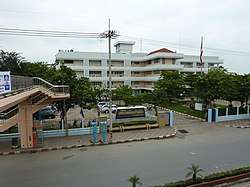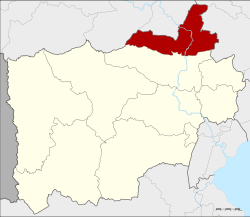Ban Pong District
Ban Pong (Thai: บ้านโป่ง, pronounced [bâːn pòːŋ]) is a district (amphoe) of Ratchaburi Province, Thailand. It is in the northeast of the province.[1]
Ban Pong บ้านโป่ง | |
|---|---|
 Ban Pong Municipal Office | |
 District location in Ratchaburi Province | |
| Coordinates: 13°48′51″N 99°52′16″E | |
| Country | Thailand |
| Province | Ratchaburi |
| Area | |
| • Total | 366.6 km2 (141.5 sq mi) |
| Population (2017) | |
| • Total | 172,752 |
| • Density | 471.22/km2 (1,220.5/sq mi) |
| Time zone | UTC+7 (ICT) |
| Postal code | 70110 |
| Geocode | 7005 |
Geography
Neighbouring districts are (from the north clockwise) Tha Muang and Tha Maka of Kanchanaburi Province, Kamphaeng Saen and Mueang Nakhon Pathom of Nakhon Pathom Province, and Photharam of Ratchaburi Province.
Ban Pong District is hilly in the western part of the district, while the eastern part is a flood plain with the Mae Klong River running through the city centre, connecting the city to the Gulf of Thailand.
History
The Mon people settled in the Ban Pong area about four centuries ago. The Mon communities have maintained some of their traditions and have built their own Buddhist temples.[2]
Later the town attracted numerous Chinese immigrants. Also many Lao Wiang communities settled in the Nong Kop subdistrict of rural Ban Pong.[3]
During the Japanese-directed construction of the Burma Railway in World War II Ban Pong was the site of one of the Japanese POW camps, Nong Pladuk, where numerous British and Allied troops were held.[4]
Two great fires occurred in Ban Pong, razing the town centre: one in 1936 and the other in 1954. The town was rebuilt in the square-grid design then fashionable, with a fountain to the south and a clock tower to the north.
Economy
Ban Pong is a railway hub, where the western railway leading to Kanchanaburi (and further to Nam Tok) splits from the southern railway leading to Singapore. Another branch connects with the town Suphanburi to the north.
As a result of high investment and fast economic development in the past decades, the town stands as one with the highest GDP per capita in western Thailand, well above national average. It is also experiencing de-industrialisation of labour-intensive industries such as canning and sugar refining. There is a large abandoned canning factory in Ban Pong town. The town is now experiencing a boom in more highly skilled industries such as auto parts, petrochemical, and food industries, with more than 70 percent of Thai buses and coaches manufactured in Ban Pong. The biggest paper making complex in Thailand lies north of the town.
As of June 2014, the National Statistics Bureau reported Ban Pong's annual GDP per capita (nominal) at US$9,623 and its annual GDP per capita (PPP) at US$24,000 compared with Thailand's US$5,675 and US$14,136 respectively.
Ban Pong is also the centre of a large pet market especially ornamental fish. There are more than 20,000 fish culture farmers, which is also the largest in southeast Asia.[5]
Sights
West of the town Ban Pong is Wat Muang, a centre of the Mon community.[6] There is also a large Roman Catholic church building and a large Buddhist temple.
Administration
The district is divided into 15 sub-districts (tambons), which are further subdivided into 182 villages (mubans). Ban Pong itself is a town (thesaban mueang) which encompasses tambon Ban Pong. Another town in the district is Tha Pha (Thai: เทศบาลเมืองท่าผา) whose administrative area covers the entire subdistrict Tha Pha and parts of Pak Raet.
There are a further four townships (thesaban tambons) including:
1.Krachap (Thai: เทศบาลตำบลกระจับ) covers parts of Nong O and Don Krabueang
2.Huai Krabok (Thai: เทศบาลตำบลห้วยกระบอก) covers parts of Krap Yai
3.Krap Yai (Thai: เทศบาลตำบลกรับใหญ่)
4. Boek Phrai (Thai: เทศบาลตำบลเบิกไพร)
and 14 other tambon administrative organizations (TAO) responsible for the non-municipal areas.
| No. | Name | Thai name | ||||||
|---|---|---|---|---|---|---|---|---|
| 1. | Ban Pong | บ้านโป่ง | 9. | Nakhon Chum | นครชุมน์ | |||
| 2. | Tha Pha | ท่าผา | 10. | Ban Muang | บ้านม่วง | |||
| 3. | Krap Yai | กรับใหญ่ | 11. | Khung Phayom | คุ้งพยอม | |||
| 4. | Pak Raet | ปากแรต | 12. | Nong Pla Mo | หนองปลาหมอ | |||
| 5. | Nong Kop | หนองกบ | 13. | Khao Khlung | เขาขลุง | |||
| 6. | Nong O | หนองอ้อ | 14. | Boek Phrai | เบิกไพร | |||
| 7. | Don Krabueang | ดอนกระเบื้อง | 15. | Lat Bua Khao | ลาดบัวขาว | |||
| 8. | Suan Kluai | สวนกล้วย |
Transport
Ban Pong Railway Station is the main railway station in the district, in Ban Pong town. There are three other railway stations in the district:
- Khlong Bang Tan Railway Station
- Nong Pladuk Junction Railway Station
- Nakhon Chum Railway Station
References
- "Ban Pong". Mapcarta. Retrieved 8 October 2016.
- Sukphisit, Suthon (2016-04-10). "Wat's the centre of Mon tradition". Bangkok Post. Retrieved 2019-03-30.
- Pumma, Samiththicha (2013). "A Study of Language and Culture of 'kîi' (feces) of Lao-Wiang in Nong Kop Subdistrict, Ban Pong District, Ratchaburi Province". Silpakorn University Journal of Social Sciences, Humanities, and Arts. 13 (2): 47–67. Archived from the original on 2016-05-13. Retrieved 2019-02-16.
- บ้านโป่ง และสถานีรถไฟบ้านโป่ง (Ban Pong Railway Station), Travel-Lindo.net Archived 2016-03-04 at the Wayback Machine
- "ตลาดกลางปลาสวยงามและสัตว์เลี้ยงจังหวัดราชบุรี" [Fish Village Ratchaburi]. DIT (in Thai).
- Svasti, Pichaya (14 September 2017). "Time-travelling along the Mae Klong River". Bangkok Post. Retrieved 16 September 2017.
External links

- Australian Prisoners of War (POWs) Ban Pong, Thailand